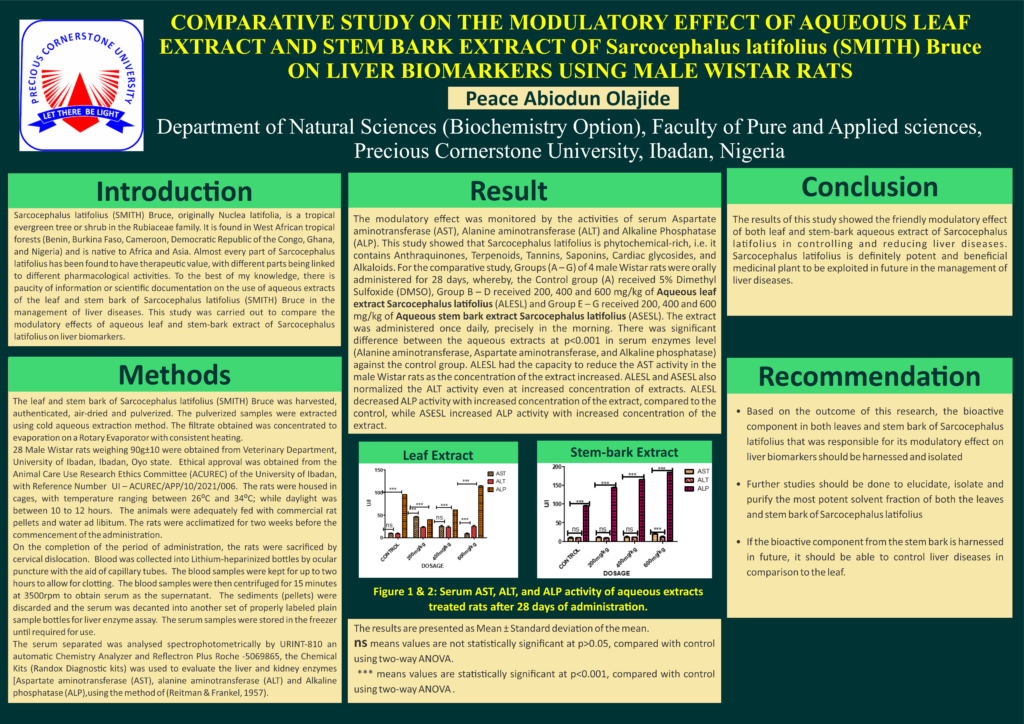Peace A Olajide
Conference 2023 Presentation
Project title
Modulatory effects of aqueous leaf and stem bark extract of Sarcocephaus latifolius (SMITH) Bruce, on Liver Biomarkers, using Male Wister rats.
Authors and Affiliations
Peace Abiodun Olajide1.
1. Department of Natural Sciences, Precious Cornerstone University, Ibadan, Oyo State, Nigeria
Abstract
Background
Sarcocephalus latifolius (SMITH) Bruce, originally Nuclea latifolia, is a tropical evergreen tree or shrub in the Rubiaceae family. It is found in West African tropical forests (Benin, Burkina Faso, Cameroon, Democratic Republic of the Congo, Ghana, and Nigeria) and is native to Africa and Asia. Almost every part of Sarcocephalus latifolius has been found to have therapeutic value, with different parts being linked to different pharmacological activities. To the best of my knowledge, there is paucity of information or scientific documentation on the use of aqueous extracts of the leaf and stem bark of Sarcocephalus latifolius (SMITH) Bruce in the management of liver diseases. This study was carried out to compare the modulatory effects of aqueous leaf and stem-bark extract of Sarcocephalus latifolius on liver biomarkers.
Methods
The leaf and stem bark of Sarcocephalus latifolius (SMITH) Bruce was harvested, authenticated, air-dried and pulverized. The pulverized samples were extracted using cold aqueous extraction method and concentrated to dryness. 28 Male Wistar rats weighing 90g±10 was obtained, and Ethical approval was obtained from the Animal Care Use Research Ethics Committee (ACUREC) of the University of Ibadan, with Reference Number UI – ACUREC/APP/10/2021/006. The rats were acclimatized for two weeks before the commencement of the administration. On the completion of the period of administration, the rats were sacrificed by cervical dislocation. Blood was collected into Lithium-heparinized bottles by ocular puncture with the aid of capillary tubes. The blood samples were then centrifuged for 15 minutes at 3500rpm to obtain serum. The serum was analyzed spectrophotometrically, the Chemical Kits (Randox Diagnostic kits) was used to evaluate the liver and kidney enzymes (Reitman & Frankel, 1957).
Results
The modulatory effect was monitored by the activities of serum Aspartate aminotransferase (AST), Alanine aminotransferase (ALT) and Alkaline Phosphatase (ALP). There was significant difference between the aqueous extracts at p<0.001 in serum enzymes level (Alanine aminotransferase, Aspartate aminotransferase, and Alkaline phosphatase) against the control group. Aqueous leaf extract of Sarcocephalus latifolius (ALESL) had the capacity to reduce the AST activity in the male Wistar rats as the concentration of the extract increased. Aqueous leaf extract of Sarcocephalus latifolius (ALESL) and Aqueous stem-bark extract of Sarcocephalus latifolius (ASESL) also normalized the ALT activity even at increased concentration of extracts. ALESL decreased ALP activity with increased concentration of the extract, compared to the control, while ASESL increased ALP activity with increased concentration of the extract.
Conclusions
The results of this study showed the friendly modulatory effect of both leaf and stem-bark aqueous extract of Sarcocephalus latifolius in controlling and reducing liver diseases. Sarcocephalus latifolius is definitely potent and beneficial medicinal plant to be exploited in future in the management of liver diseases.

